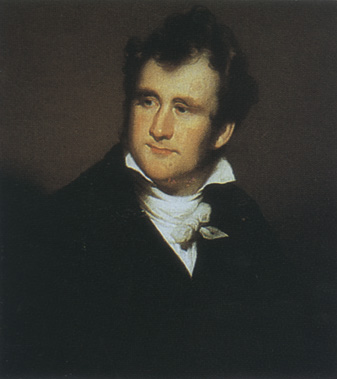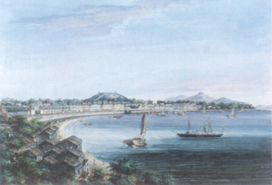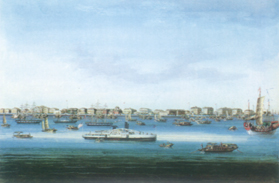§ 1. THE COMMANDER OF THE VESSEL
 James Perkins Sturgis, the commander of the Atahualpa.
In: HUNTER. William C., An American in Canton (1825-44), Hong Kong. Derwent Communications. 1994.
Hong Kong Bank Collection.
James Perkins Sturgis, the commander of the Atahualpa.
In: HUNTER. William C., An American in Canton (1825-44), Hong Kong. Derwent Communications. 1994.
Hong Kong Bank Collection.
The vessel was called Atahualpa and the name of its commander was William Sturgis.
Before dealing with the event as such, we will give some details about the ship's commander.
William Sturgis was born in London, on the 25th of February 1782 and died at eighty one years old, in Boston, on the 21st of October 1863.
The only descendent of William Sturgis and Hannah Mills, he emigrated with his fathers to Boston in 1796, when he was barely fourteen. His first job was in his uncle Russel Sturgis's company but it did not last long because eight months later he entered the service of James and Thomas Handasyd, who owned a company trading between the United States east coast and China.
After his father's death in 1797 his economic situation was so precarious that he decided to serve at sea. When he was nineteen, after the sudden death of the commander of the ship Cardine, he was offered the deceased's post.
In 1809 he was the commander of the Atahualpa on a non-stop trip between Boston and Macao, when the ship entering the harbour of Macao was attacked by pirates.
In April 1810 he was again in Boston. Shortly after he made a partnership with John Bryant and together they founded an enduring company named Bryant and Sturgis, only dissolved more than fifty years later, following William's death, in 1863. The company rapidly prospered, from 1810 to 1850 controlling more than half the trade between the United States and China together with the Pacific Island territories.
In 1810, William Sturgis married Elizabeth Davis, the daughter of John Davis a United States government district court magistrate. They had several children.
From 1814 to 1845 Sturgis was a member of the Massachusetts Senate House.
Francis Bacon Lothrop, an honorary trustee of the Peabody Essex Museum in Salem, Massachusetts is a descendent of both William Sturgis and Daniel C. Bacon who also traveled in the Atahualpa in 1809 from Boston to Macao, with his parents.
In fact, one of William Sturgis's daughters named Anne married a certain Samuel Hooper. Anne and Samuel had a daughter named Anna Maria Hooper who married Thornton Lorthrop. Anna Maria and Thornton had a son named William Hooper Lothrop who married Alice Bacon. Daniel C. Bacon Lothrop was the son of William and Alice. Alice Bacon's father was Francis E. Bacon who was in turn the son of Daniel C. Bacon who traveled in the Atahualpa in 1809 from Boston to Macao, with his parents.
§2. THE ATAHUALPA IN MACAO
Hosea Ballou Morse narrates:
"The American ship Atahualpa, 200 tons, Captain Sturgis, from Boston, dropped anchor on August 23, 1809, in Macao Road and sent a boat ashore for a pilot, the men on board being thus reduced to eleven; she was then attacked by a considerable Fleet of Ladron Boats, which she beat off and took shelter under the guns of Macao."1
This incident was told by William Sturgis to Robert Bennet Forbes, who was later to describe it amid the monotony in the following manner:
"Amid the monotony in this dull commercial record, it may not be amiss to introduce the story of the famous escape of the Atahualpa, even though sadly shorn of the interest given when heard from the lips of Capt. William Sturgis, the hero of it.
Early in this century Mr. Theodore Lyman, the grandfather of the present Col. Lyman, then a large shipowner, fitted out for China the little ship Atahualpa, giving the command of her to young Captain William Sturgis.
She had been engaged in the Northwest coast trade with the Indians and had her half-poop and topgallant forecastle decks pierced for musketry, besides carrying four six-pounders. There being no more peaceful service in those days than the China trade, Mr. Lyman directed the cannon to be left ashore as useless lumber, but his young captain, ambitious to have something like an armed ship under him, luckily managed to carry them along. It is said, but hardly credible, that his stern, old-fashioned owner subsequently reprimanded him, notwithstanding the result, for his breach of orders, and made him pay freight on the guns. If he did, those who knew the sterling qualities of the owner will be sure that it was done as a lesson to a young commander to obey orders if he broke with the owners, and that the fine was amply made up in some other shape.
Young James Perkins Sturgis, well known to us of that generation as "Uncle Jim", was a passenger, and also Mr. Bumstead, who had lost a brother by Indians or pirates, and whose natural nervousness, it will be seen, was one means of saving the ship. The chief mate was Daniel C. Bacon, then a young man, but well known as a successful merchant and ship owner - especially standing out in men's memories as an example of all that is manly, brave, and reliable.
In those days, without either steam or telegraph, news from China were usually from four to six months old when a ship left port, and of course about double that age when she reached her destination, and in the interval between Capt. Sturgis's sailing and arriving in Macau Road a powerful fleet of Chinese pirates had taken entire possession of the approaches of Canton, so that no unarmed vessel attempted to enter; and in one case a British gunbrig, loosing her masts in a typhoon and looking very helpless, was attacked by them. The story goes that, seeing the cut-throats approaching at night, the Captain, like "Brer Rabbit" in the fable, "laid-low", kept his ports closed, his battlelanterns dark, with his crew at quarters and his guns double shotted, held together by a cable, intended to take his bows and bring them with their horde of wasps right alongside; their programme was carried out, and when they got under his guns the signal was given, ports and lanterns up, and the scoundrels sank without mercy.

Macao.
Ca 1850. Gouache on paper. 31.0 cm x 36.0 cm.
In: Pinturas da "China Trade", Macau, Instituto Cultural de Macau, [d. n. n.], ill. no 39.
Instituto de Investição Científica Tropical (Arquivo Histórico Ultramarino) Collection.
To such enemies the unsuspecting Atahualpa came near surrendering without a shot. She anchored far outside of Macau in the calm, and sent her first mate, Daniel C. Bacon, with four of her scant crew, ashore for a pilot.
The stillness was soon interrupted by Mr. Bumstead's calling the Captain’s attention to a fleet of junks in line of battle floating down upon them in a threatening manner. Capt. Sturgis laughed at his fears of the peaceful fishermen, but, to satisfy him, ordered a gun loaded and a shot thrown across the bow of the leading junk, "just to show how soon it will bring them about on the other tack." The shot splashed under the bows, but they kept straight on - then it was a race for life. The cable was slipped, and all hands, passengers included, sent to loose the foretopsail, and get her head towards shore before a light easterly breeze which was springing up. There had not been a second to lose, for the leading pirate, swarming with savages, was coming down on her quarter and trying with long poles and the well-remembered pilot's hook to catch the end of her spanker-boom, and, under a sharp fire of musketry, barely fell short.
With the four little cannon loaded, she now kept the enemy from coming alongside, who pursued with fearful yells, firing jingalls and fire-balls upon her deck and not deterred by the slaughter which was made by the determined crew, who fired constantly into their crowded decks without their flinching in the least. The cruelty of the Chinese pirates was well known, and Capt. Sturgis had a barrel of powder ready, with which he told his crew he would blow them all up if the pirates once got possession of the ship - but meantime he made every preparation for keeping them out, having the cabin and forecastle defended through its loopholes in case they reached the decks.
While the fighting was going on, Daniel Beacon had reached the shore, and, asking for a pilot, was told the full state of things, and that his vessel no longer had any chance of escape. Without waiting a moment and almost by force, he tore himself away from the guard, who, considering his case hopeless tried to detain him, and, pushing his men into the boat, pulled of to the ship in the midst of action, and took his part in the defense. A British frigate was lying in the Typa [Taipa], but without wind could not move to the rescue. Her boats were armed and manned, and the Macau Forts began also to throw their shot among the pirates, and finally the Atahualpa drifted into the harbour, and, having no anchor available, ran ashore under the guns of the forts.
It is related that the Uncle "Jim Sturgis" had been victim to sea-sickness jaundice the whole voyage, and was as yellow as a sunflower all the way but the excitement of the fight completely cured him. The Chinamen had for the second time caught a Tartar, the destruction of their crowded decks being enormous, for the small arms were constantly plied in short pistol-shot by desperate men. No one who remembers Capt. Sturgis's shaggy eyebrows and determined face will doubt that he did not throw away one ounce of lead, and that he was perfectly capable of carrying into effect his promise of blowing up the ship as a last resort against the well-known cruelty of the pirates in case of capture."2

Canton.
Ca 1850. Gouache on paper. 31.0 cm x 36.0 cm.
In: Pinturas da "China Trade", Macau, Instituto Cultural de Macau, [d. n. n.], ill. no 41.
Instituto de Investição Científica Tropical (Arquivo Histórico Ultramarino) Collection.
NOTES
1. MORSE, Hosea Ballou, The Chronicles of the East India Company trading to China 1635-1834, 4 vols., Oxford, Oxford University Press, 1926, vol.3, p. 108 - Volume 5 was published in 1929.
2. FORBES, Robert Bennet, Personal Reminiscences [to which was added a chapter IX] Rambling Recollections Connected with China, Boston, Little - Brown & Company, 1892, pp.391-394 - Chapter IX was added to the second and third editions, respectively published in 1882 and 1892.
start p. 49
end p.